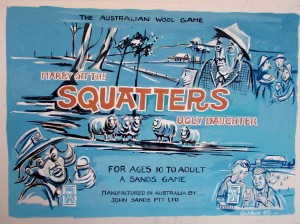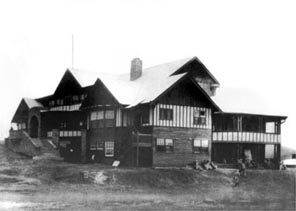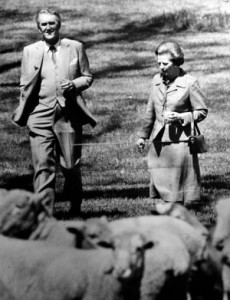Dear reader, once again, (how lucky you are) we offer you another piece from the Cockburn Collection. Games that were produced during the Ming Dynasty, (1939-66) which give a scintillating insight into the emergent cultural trends within the card rooms and games rooms of rural Australia. 
‘Marry off the Squatters Ugly Daughter’, (1948), was developed hot on the heels of the successful ‘Squatter’ board game. The initiative was based firmly on the request by those western district graziers nervous before the full impact of the wool boom, as to what to do with their unmarried daughters. Unmarried daughters constituted a significant bane for this constituency, who were burdened with un-marriageable daughters and escalating costs of wages and machinery. They discovered that in spite of the expensive education at Melbourne’s elite private schools and the conventional introduction at court to the royal family, a crushing reality of being unable to find a worthy suitor.
John Sands and Co, seized the initiative and developed a board game very closely linked to their stable mate “Squatter”, and made some minor changes to the rules and structure. Whereas Squatter was based upon the development of grazing holdings, stocking and pastoral expansion, the ‘Ugly Daughter’ was based upon the establishment of a round of social and sporting engagements in which potential suitor’s would be primed with refreshment and entertainment, to a degree and intensity to which a marriage proposal would be forthcoming. The inducements to marriage were the promise of a stake in the family pastoral empire, use of servants, and a panoply of gratuities suggestive of long holidays at Barwon Heads, opportunity to purchase equipment on field days, and possible access to the Melbourne Club.
Participants were encouraged to play, (as a precursor to online gaming) by making transactions over the phone, and arrange to meet at tennis tournaments, Gymkhana’s and meetings of the wool board. Once engaged the transactional arrangements would be met and a budget allocated for wooing and wedding. If the inducements failed to find a suitable partner, the process would repeat itself until as such time a suitor was found, or the estate was depleted. If the estate was depleted, to a significant extent, the wild card offered an internship at a university, or a position at the red cross and a lifetime of charitable engagements which would mitigate the overall cost burden.
The winner, would be those who succeeded in marriage, and the losers, those who proclaimed un-marriage-able, would ‘retire” and pursue life as weekend artist, poet, or unpublished writer of serious fiction. As compensatory gesture a lifetime membership was offered to the Lyceum Club.
The game was released for testing at the St Catherine’s School in Heyington Place, and achieved an enthusiastic response, until it was revealed a proliferation of ‘sham marriages’ to music teachers, interior designers, and anglican clerics outraged the core constituency who financed the initiative, and the game was withdrawn. Fortuitously this edition survives, and is still played for match sticks and drinks tokens at the Hamilton Club, where the principles attendant to the spirit of the game survive. And there is a rumour, (as yet unsubstantiated) that an adaptation of the game is being sought by the Attorney General Mr George Brandis as an instructional tool for his ‘Outstanding Achievers in Australian Art Awards’.




